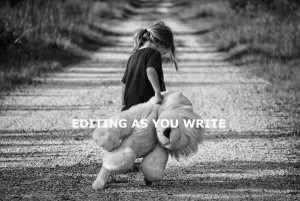Last week, I posted on writing blog content faster. But in some important ways, writing your story faster differs from writing blog content faster. Here are suggestions for writing stories faster.
Before You Write
- Ask, “What am I saying to myself?”
- Is it something like, “I’ve always edited as I go, because I’m good at editing and enjoy molding each chapter, page, or paragraph until I’m satisfied. This is my comfort zone. I put off writing more of the story, because that’s the more elusive part of writing.”
- Answer honestly:
- “When a section is finally the way I want it, have I been away from the story so long that it takes me awhile to get back into the story’s flow?”
- “How many times have I had to delete or rewrite beautifully edited scenes because of changes I made to the story later?”
- Don’t give in to thoughts saying you can’t write without editing.
- Give yourself time to establish a pattern of success.
Suggestions:
- You already know editing is easier than writing for you, so get a draft done so you have the whole story to attack with your editing skills.
- Writing fast turns off the internal editor or censor and allows creativity to flow.
- Writing without editing forces you to stay in the story.
- Allow your mind to spill out what it knows without you interrupting it to find a better word or fix a typo.
- Do the prep work. Writing faster is easy when you know what you want to say. You decide how much detail you need to know to get started. What do you need?
Suggestions:
- One-sentence tagline
- Reader’s takeaway, plot idea, and a hero and heroine
- Hero’s journey outline
- Plot cards
- Scene cards
- Major turning points
- Goals, motivations, and conflicts
- Synopsis
- Set-up chapters
- Put some kind of accountability in place.
4. Find your most productive writing time.
Write the Story Faster
5. Write as fast as you can.
Suggestions:
- Lower your standard for the first draft.
- Don’t allow distractions. Stay focused.
- Set a timer for a chunk of time and refuse to edit or stop until the time is up.
- Don’t delete a poor sentence; write another version and go on.
- Turn off or cover the monitor. If you can’t see errors, you’re less likely to stop and fix them.
- Don’t’ lose momentum. If you think of a change for a previous chapter, jot a note and keep going.
After the Messy Draft Is Written
- Edit your post.
Suggestions:
- Check the flow (move paragraphs or chapters).
- Fix typos and misspellings.
- Make scenes ground the reader immediately.
- Replace weak nouns and verbs with strong ones.
- Limit adjectives, adverbs, and unnecessary words.
- Make dialogue tight, necessary, and interesting.
- Reverse reactions written before stimuli.
- Make actions linear.
- Add color and senses.
- Change wordy or confusing sentences.
- Fix inconsistencies.
- Let it sit and then read it through again.
Suggestions for writing your story faster. Click to tweet.
What other ways help you write your story faster?






 RSS - Posts
RSS - Posts



I will try these suggestions. But I have one question. Excactly what is “Reader’s Takeaway”?
Good question, Laurean. For me, it’s what I want the reader to have received from my character’s growth arc, e.g. when we think we’re better than others, it gets us into a lot of trouble and pain.
Oh dear, I transposed the “a” and the “c” “exactly.” LOL. I forgot to say, this post could be a lifesaver for a lot of writers. Thanks, Zoe.
No problem, Laurean. For once, spell check didn’t do its thing that it often does when you don’t want it to. :0)
Good advice, Zoe. It’s so tempting to perfect a chapter before going on to the next, something of which I’m sooooo guilty. And you cover some great details. Thanks for posting.
I’m tempted too, Peggy. I’m not to the point of covering my screen, though.
Hi Zoe, this is so true to what I’ve found in my research on writing productivity! Lots of good suggestions. I am curious about your references to plot cards and scene cards. Could you give a further explanation please? Or do you have blog posts addressing these as well? Thanks!
Hello kerouser, plot cards are index cards on which you write the events that you plan to happen in the story – plot points, points at which something changes. Scene cards are similar. You write out a sentence of what happens in each scene. Using index cards allows you to rearrange events and scenes in order to have good story flow and a progressing character arc (character growth). Here’s a link that goes into detail about both kinds of cards. http://mythcreants.com/blog/three-excuses-to-use-office-supplies/ Hope this helps.
Hi Zoe! Thanks for your response. I will check out the article you linked to. I kind
of thought you were referring to using index cards. I’ve found them helpful when rewriting
and adding content. I appreciate the helpful suggestions. Kathy Rouser
You’re welcome, Kathy. I think I tried index cards and sticky notes a long time ago. But for me, I do better with mapping out the hero’s journey.